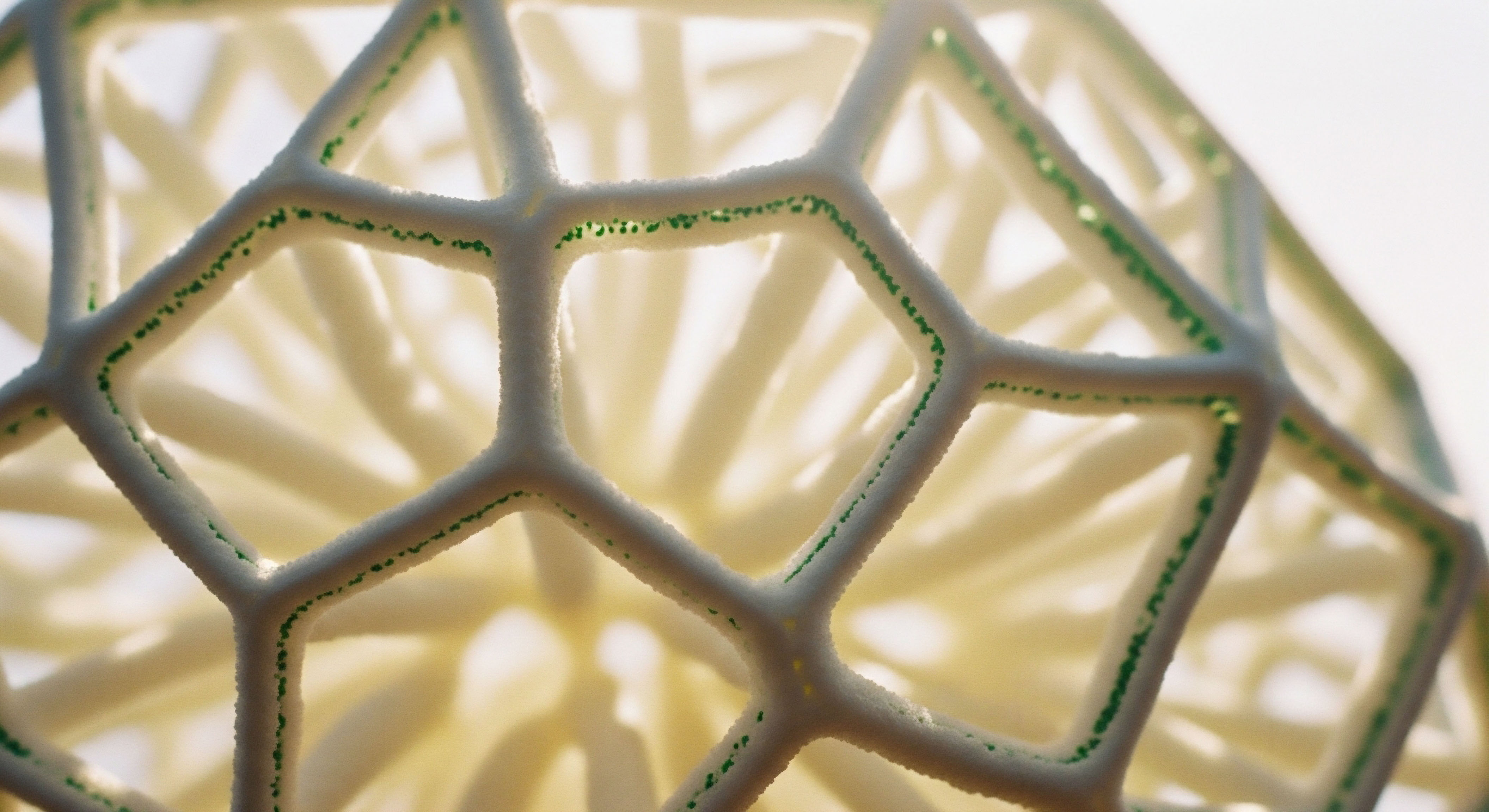

Fundamentals
The experience of seeing more hair in your brush or noticing a change in your hairline is a deeply personal one. It often brings a sense of concern that goes far beyond vanity. This response from your body is a signal, a message from your intricate internal ecosystem.
Understanding the origin of that signal is the first step toward addressing it with intention and clarity. Your hair is a dynamic extension of your biological self, deeply connected to the complex symphony of your endocrine system, your metabolic health, and the very blueprint of your genetics. The journey to supporting hair vitality begins with appreciating the biological marvel that is the hair follicle.
Each hair on your head grows from a sophisticated mini-organ known as the hair follicle. This structure is a bustling hub of cellular activity, with its own cycle of growth, transition, and rest. The growth phase, or anagen phase, is a period of intense cellular division and construction, where the hair shaft is actively built.
Following this is a brief transitional phase (catagen), and finally, a resting phase (telogen), after which the hair is shed to make way for a new one. The health and duration of the anagen phase are paramount to maintaining hair density and length. This entire cycle is exquisitely sensitive to your internal environment, responding to hormonal cues, nutrient availability, and circulatory health.

The Hormonal Influence on Hair Follicles
In many forms of hair thinning, particularly androgenetic alopecia (AGA), which affects both men and women, the primary influencing factors are genetics and hormones. AGA is characterized by a genetically determined sensitivity of hair follicles to androgens, specifically dihydrotestosterone (DHT).
Testosterone, a primary androgen in both sexes, is converted into the more potent DHT by an enzyme called 5-alpha reductase, which is present in the scalp’s oil glands and hair follicles. In individuals with a genetic predisposition, DHT binds to receptors in the hair follicles and initiates a process of follicular miniaturization.
This means that with each successive hair cycle, the anagen phase becomes shorter, and the follicle itself shrinks. The result is a hair that is progressively shorter, finer, and less pigmented, eventually becoming a microscopic vellus hair that fails to provide meaningful scalp coverage.
Traditional treatments for hair loss have been developed with a direct focus on counteracting these specific mechanisms. They represent well-understood and clinically validated approaches to interrupting the progression of androgenetic alopecia.
- Finasteride ∞ This oral medication operates by inhibiting the 5-alpha reductase enzyme. By reducing the conversion of testosterone to DHT, it lowers the concentration of this potent androgen in the scalp, thereby protecting susceptible follicles from miniaturization. Its action is systemic and directly targets the biochemical pathway responsible for producing the primary antagonist of the hair follicle in AGA.
- Minoxidil ∞ This topical solution functions through a different, yet complementary, mechanism. It is a vasodilator, meaning it widens blood vessels and improves blood flow to the scalp. This enhanced circulation delivers more oxygen and essential nutrients directly to the hair follicles. It is also believed to work by opening potassium channels in the cells, which can help prolong the anagen phase, allowing for longer and thicker hair growth. It supports the follicle’s metabolic needs.
These established therapies form the bedrock of conventional hair restoration protocols. They are effective because they target known, primary drivers of hair loss. One reduces the hormonal assault on the follicle, while the other improves the follicle’s local environment and nutritional supply.
Understanding this foundation is essential, as it provides the context for how newer, regenerative approaches like peptide therapies can be layered in to create a more comprehensive and synergistic protocol. The goal moves from simply defending the follicle to actively rejuvenating its function and its environment.


Intermediate
Building upon the foundational understanding of hair loss, we can begin to assemble a more sophisticated and integrated strategy. The body’s language is one of signals and cascades. Hormones and peptides are the messengers, carrying instructions that dictate cellular behavior.
While traditional therapies effectively run interference on the primary negative signals in androgenetic alopecia, peptide therapies introduce new, positive signals. These peptides are short chains of amino acids, the building blocks of proteins, that act as precise biological communicators. They can instruct cells to heal, grow, and regenerate. Integrating these regenerative signals with conventional treatments allows for a multi-pronged approach that addresses the issue from several angles simultaneously.
Peptide therapies introduce specific, regenerative signals that can enhance the scalp environment and support follicular health in ways that complement traditional treatments.
The logic behind this integration is rooted in cellular synergy. Traditional treatments create a more permissive environment for hair growth; peptides provide the active building blocks and restorative instructions for that growth to occur. This is about moving from a defensive posture to a proactive, regenerative one. We will examine three specific peptides that exemplify this principle ∞ GHK-Cu, BPC-157, and the combination of CJC-1295 and Ipamorelin.

Targeted Peptides for Follicular Rejuvenation

GHK-Cu a Foundational Healer
GHK-Cu is a copper peptide, a small protein fragment complexed with a copper ion. It is naturally present in human plasma, though its levels decline with age. Its function in the body is profoundly regenerative. When applied topically to the scalp, it initiates a cascade of beneficial effects that directly support the hair follicle.
- Extracellular Matrix Remodeling ∞ GHK-Cu stimulates the synthesis of collagen and elastin, key structural proteins that provide integrity and elasticity to the skin and scalp. A healthier, more robust scalp structure provides better anchoring for the hair follicle.
- Anti-Inflammatory Action ∞ Chronic micro-inflammation is a known contributor to follicular damage in AGA. GHK-Cu has potent anti-inflammatory and antioxidant properties, protecting follicles from the damaging effects of oxidative stress and free radicals.
- Angiogenesis and Blood Flow ∞ Similar to minoxidil, GHK-Cu promotes the formation of new blood vessels, a process called angiogenesis. This improves circulation, ensuring a steady supply of nutrients and oxygen to the metabolically active hair follicle cells.
- Follicle Stimulation ∞ Studies suggest that GHK-Cu can increase the size of hair follicles and prolong the anagen (growth) phase of the hair cycle. Some evidence also indicates it may have a local DHT-blocking effect, further protecting the follicle.

BPC-157 the Angiogenic Powerhouse
Body Protection Compound 157, or BPC-157, is a synthetic peptide derived from a protein found in the stomach. It is renowned for its systemic and localized healing capabilities, particularly its influence on blood vessel growth. Its primary mechanism of action relevant to hair health is its powerful pro-angiogenic effect.
BPC-157 significantly upregulates Vascular Endothelial Growth Factor (VEGF), a key signaling protein that stimulates the formation of new blood vessels. A dense vascular network is critical for sustaining the high metabolic demands of a growing hair follicle. By enhancing the scalp’s vascularity, BPC-157 ensures that follicles receive the robust blood supply needed to sustain a healthy anagen phase.
This mechanism works in beautiful concert with minoxidil; while minoxidil widens existing vessels, BPC-157 helps to build new ones, creating a more resilient and comprehensive circulatory network for the entire scalp. It also has strong anti-inflammatory properties, further calming the scalp environment.

Systemic Support with Growth Hormone Secretagogues
What if you could enhance the fundamental capacity for cellular repair throughout your entire body? This is the role of growth hormone secretagogues like the combination of CJC-1295 and Ipamorelin. These are not direct hair-growth peptides; they are systemic agents that optimize the body’s primary repair and regeneration pathways.
- CJC-1295 ∞ This is a long-acting analog of Growth Hormone-Releasing Hormone (GHRH). It signals the pituitary gland to release growth hormone (GH) in a natural, pulsatile manner that mimics the body’s own rhythms.
- Ipamorelin ∞ This is a Growth Hormone Releasing Peptide (GHRP) that also stimulates the pituitary to release GH, but through a different receptor (the ghrelin receptor). It is highly selective and does not significantly impact other hormones like cortisol.
When used together, they create a potent, synergistic release of growth hormone. This elevated GH level then stimulates the liver to produce Insulin-Like Growth Factor 1 (IGF-1), a primary mediator of GH’s effects. IGF-1 is a powerful force for cellular growth, proliferation, and regeneration in virtually every cell in the body, including the dermal papilla cells of the hair follicle.
By elevating IGF-1 systemically, you are providing a foundational anabolic and regenerative signal that supports the health of all tissues, including hair. This protocol works from the inside out, improving the body’s intrinsic ability to heal and grow, which in turn supports the efficacy of targeted topical treatments.

How Do Peptide Therapies and Traditional Treatments Compare?
To visualize how these therapies integrate, it is useful to compare their primary mechanisms of action. They do not compete; they collaborate at different levels of the biological system.
| Therapy | Primary Mechanism of Action | Biological Target | Method of Administration |
|---|---|---|---|
| Finasteride | Inhibits the 5-alpha reductase enzyme, reducing systemic DHT. | Hormonal Pathway | Oral |
| Minoxidil | Acts as a vasodilator and potassium channel opener, increasing blood flow. | Circulatory/Cellular Membrane | Topical |
| GHK-Cu | Promotes collagen synthesis, reduces inflammation, and improves local circulation. | Local Tissue Environment | Topical |
| BPC-157 | Stimulates angiogenesis (new blood vessel formation) via VEGF upregulation. | Circulatory/Tissue Repair | Subcutaneous/Topical |
| CJC-1295 / Ipamorelin | Increases systemic levels of GH and IGF-1, promoting global cellular repair. | Endocrine System (Pituitary) | Subcutaneous |
This integrated model addresses hair loss comprehensively. Finasteride reduces the primary antagonist (DHT). Minoxidil improves local hemodynamics. GHK-Cu rebuilds the scalp’s structural integrity and calms inflammation. BPC-157 builds new circulatory pathways. And CJC-1295/Ipamorelin elevates the body’s foundational regenerative capacity. Each component addresses a different facet of the complex pathology of hair loss, creating a more robust and resilient system for hair vitality.


Academic
An academic exploration of integrated hair restoration protocols requires a shift in perspective, moving from organ-level observations to the intricate world of cellular signaling pathways. The health of a hair follicle is the macroscopic output of a microscopic dialogue between various cell types, governed by a precise language of growth factors and intracellular messengers.
The convergence of traditional and peptide-based therapies is most elegantly understood at this molecular level, specifically through their collective influence on the Wnt/β-catenin signaling pathway, a master regulator of hair follicle morphogenesis and cycling.
Androgenetic alopecia is, at its core, a disease of pathological signaling. The binding of dihydrotestosterone (DHT) to the androgen receptor in dermal papilla cells does not simply cause a mechanical shrinking. It initiates a transcriptional cascade that alters the expression of numerous genes, including those that encode for growth factors and their inhibitors.
This leads to a foreshortened anagen phase and the progressive miniaturization of the follicle. The ultimate goal of a sophisticated, integrated therapy is to rewrite this dysfunctional cellular dialogue, suppressing negative signals while amplifying the positive signals that promote and sustain the anagen phase.

The Wnt/β-Catenin Pathway the Follicle’s on Switch
The Wnt/β-catenin pathway is a highly conserved signaling cascade that plays a fundamental role in embryonic development and adult tissue regeneration, including that of the hair follicle. Activation of this pathway is the critical trigger that coaxes hair follicle stem cells from their dormant state in the telogen phase and initiates the proliferative activity of the anagen phase.
The pathway’s mechanism is a model of cellular elegance. In its “off” state, a protein complex continuously targets β-catenin for destruction, keeping its cytoplasmic levels low. The arrival of a Wnt protein ligand at the cell surface, where it binds to a Frizzled receptor complex, initiates the signaling cascade.
This binding event deactivates the destruction complex. As a result, β-catenin is no longer targeted for degradation. It accumulates in the cytoplasm and subsequently translocates to the nucleus. Inside the nucleus, β-catenin partners with transcription factors to activate the expression of a suite of genes responsible for cell proliferation, differentiation, and ultimately, the initiation of the anagen phase. Dysregulation or suppression of this pathway is a key feature of hair loss.
The integration of advanced therapies succeeds by creating a biochemical environment that favors the sustained activation of the Wnt/β-catenin pathway, the molecular engine of the hair growth cycle.

How Integrated Therapies Modulate the Signaling Environment
A truly effective protocol modulates the cellular milieu to make the activation of Wnt/β-catenin more probable and more sustainable. Each therapeutic modality contributes a unique piece to this complex puzzle.

Traditional Therapies Setting the Stage
- Finasteride ∞ By systemically lowering DHT, finasteride removes a powerful transcriptional repressor of hair growth. DHT is known to promote the expression of certain Wnt inhibitors, such as DKK1. By reducing DHT, finasteride lifts this suppressive pressure, making the cellular environment more receptive to pro-growth Wnt signals. It clears the static from the communication line.
- Minoxidil ∞ Its vasodilatory effect improves the metabolic capacity of the follicular cells. A cell that is well-supplied with oxygen and nutrients is more capable of executing the energy-intensive processes of proliferation demanded by Wnt/β-catenin activation. Furthermore, some research suggests that minoxidil may directly upregulate β-catenin in dermal papilla cells, providing a more direct link to the pathway.

Peptide Therapies Amplifying the Signal
- GHK-Cu ∞ This peptide’s influence is multifaceted. Its anti-inflammatory action is critical because inflammatory cytokines are known to inhibit hair growth and can interfere with Wnt signaling. By quenching inflammation, GHK-Cu creates a more stable signaling environment. Its stimulation of collagen and other extracellular matrix components improves the structural context for cell-to-cell communication. Healthy dermal papilla cells, supported by a robust matrix, are more effective at producing the Wnt ligands needed to activate the pathway.
- BPC-157 ∞ The profound angiogenic effect of BPC-157, driven by VEGF, is directly supportive of the anagen phase. The anagen follicle is a highly vascularized structure. VEGF and Wnt/β-catenin signaling are deeply interconnected; activation of β-catenin can induce VEGF expression, and a healthy vascular supply is necessary to support the resulting cellular expansion. BPC-157 ensures the circulatory infrastructure can meet the demands of a fully activated anagen follicle.
- CJC-1295/Ipamorelin ∞ This combination’s systemic elevation of IGF-1 provides a powerful, global pro-survival and pro-growth signal. IGF-1 is a critical downstream effector in many growth pathways and is known to interact with the Wnt/β-catenin cascade. It can promote the proliferation of dermal papilla cells and enhance their inductive properties, making them more potent sources of Wnt signals. An elevated systemic IGF-1 level essentially primes the entire system for growth and repair, ensuring that follicular cells have the foundational support they need to respond robustly to localized growth signals.

A Systems-Biology View of Hair Restoration
This table outlines the specific cellular and pathway-level targets of each therapeutic agent, illustrating the synergistic nature of an integrated protocol from a molecular biology perspective.
| Therapeutic Agent | Molecular/Cellular Target | Effect on Signaling Environment | Contribution to Hair Cycle |
|---|---|---|---|
| Finasteride | 5-alpha reductase enzyme | Reduces DHT, potentially decreasing expression of Wnt inhibitors (e.g. DKK1). | Removes a primary inhibitory signal, allowing for anagen prolongation. |
| Minoxidil | Potassium channels; Vasculature | Increases local blood flow and may directly upregulate β-catenin. | Improves metabolic support for anagen; may directly stimulate growth pathways. |
| GHK-Cu | Fibroblasts; Inflammatory cells | Increases collagen/ECM; reduces inflammatory cytokines and oxidative stress. | Improves scalp structural integrity and reduces signaling interference. |
| BPC-157 | Endothelial cells (via VEGF) | Promotes angiogenesis, creating new blood vessels. | Builds the vascular infrastructure required to sustain a metabolically active anagen follicle. |
| CJC-1295 / Ipamorelin | Pituitary somatotrophs; Liver | Increases systemic GH and IGF-1 levels. | Provides a global pro-growth and pro-survival signal to all cells, including dermal papilla. |
Viewing hair loss through this lens reveals its nature as a systems-level dysfunction. A successful intervention, therefore, must also be a systems-level solution. It involves reducing hormonal antagonism with finasteride, improving local energetics with minoxidil, rebuilding the local tissue environment with GHK-Cu, expanding the circulatory network with BPC-157, and elevating the body’s intrinsic regenerative potential with growth hormone secretagogues.
This integrated approach works because it respects the biological complexity of the hair follicle, addressing multiple points of failure within the system to collectively bias the cellular environment toward the sustained, robust activation of the anagen phase.

References
- Pickart, Loren, and Anna Margolina. “Regenerative and Protective Actions of the GHK-Cu Peptide in the Light of the New Gene Data.” International Journal of Molecular Sciences, vol. 19, no. 7, 7 July 2018, www.ncbi.nlm.nih.gov/pmc/articles/PMC6073405/.
- Harchani, T. et al. “BPC 157 and its role in accelerating musculoskeletal soft tissue healing.” Annals of Medicine and Surgery, vol. 62, 2021, pp. 102022.
- Teichman, S. L. et al. “Prolonged stimulation of growth hormone (GH) and insulin-like growth factor I secretion by CJC-1295, a long-acting analog of GH-releasing hormone, in healthy adults.” Journal of Clinical Endocrinology & Metabolism, vol. 91, no. 3, 2006, pp. 799-805.
- Adil, A. & Godwin, M. “The effectiveness of treatments for androgenetic alopecia ∞ A systematic review and meta-analysis.” Journal of the American Academy of Dermatology, vol. 77, no. 1, 2017, pp. 136-141.e5.
- Lolli, F. et al. “Androgenetic alopecia ∞ a review.” Endocrine, vol. 57, no. 1, 2017, pp. 9-17.
- Kwak, S. S. et al. “Targeting Wnt/β-Catenin Pathway for Developing Therapies for Hair Loss.” International Journal of Molecular Sciences, vol. 21, no. 14, 2020, p. 4915.
- Cheon, S. Y. et al. “Wnt/β-catenin signaling activator restores hair regeneration suppressed by diabetes mellitus.” Journal of Investigative Dermatology, vol. 140, no. 1, 2020, pp. 24-34.e4.
- Raqual, O. et al. “Ipamorelin, the first selective growth hormone secretagogue.” European Journal of Endocrinology, vol. 139, no. 5, 1998, pp. 552-561.
- Ho, K. Y. et al. “Effects of a fusion protein of growth hormone-releasing hormone and human albumin on growth hormone and insulin-like growth factor 1 in healthy adults.” The Journal of Clinical Endocrinology & Metabolism, vol. 91, no. 10, 2006, pp. 3917-3922.
- Seo, S. H. et al. “Wnt5a Suppresses β-catenin Signaling during Hair Follicle Regeneration.” International Journal of Molecular Sciences, vol. 20, no. 23, 2019, p. 5891.

Reflection
The information presented here offers a map of the biological territories involved in hair health. It details the pathways, the signals, and the mechanisms that govern the life cycle of a hair follicle. This knowledge is a powerful tool, shifting the perspective from one of passive concern to one of active understanding.
Your body is constantly communicating its state of balance. The changes you observe are not isolated events; they are data points, providing insight into a much larger, interconnected system.
This clinical framework serves as a guide to the available tools and strategies. It illuminates how different protocols can work in concert, addressing the complexity of the issue from multiple, synergistic angles. The path forward involves taking this foundational knowledge and applying it to your unique biological context.
Every individual’s physiology is distinct, a product of their genetics, history, and lifestyle. The true work begins in using this understanding as the starting point for a personalized dialogue about your health, a conversation aimed at restoring the systems that support your vitality from the inside out.

Glossary

anagen phase

androgenetic alopecia

follicular miniaturization

5-alpha reductase

traditional treatments

hair loss

5-alpha reductase enzyme

peptide therapies

cjc-1295 and ipamorelin

bpc-157

ghk-cu

extracellular matrix

angiogenesis

growth factor

growth hormone secretagogues

ipamorelin

growth hormone

cjc-1295

insulin-like growth factor

dermal papilla cells

dermal papilla

wnt/β-catenin pathway




